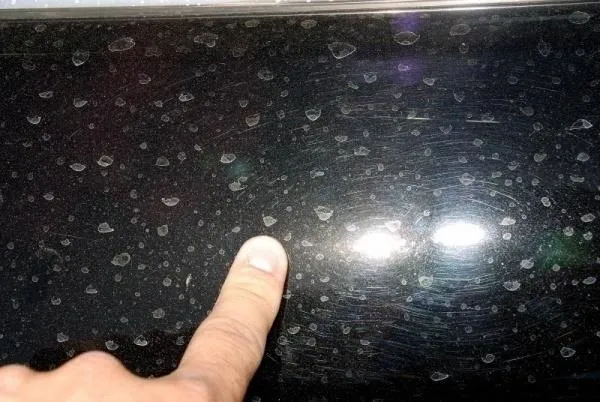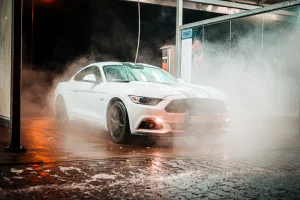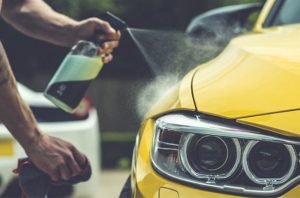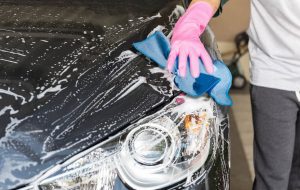Hard water spots on your car’s paint are caused by mineral deposits that form over time, but they can be removed using various techniques including vinegar solutions, baking soda solutions or clay bar treatment.
Step one of our car wash process includes using two buckets filled with soapy water and rinsing it off using a hose, followed by soaking a microfiber towel in distilled water to wipe down your vehicle.
Clay Bar
Professional detailers use an unheralded solution called detailing clay to remove stubborn water spots on their vehicles, much like soft artist’s clay does. Like its name implies, detailing clay grabs contaminants firmly attached to surfaces before lifting it safely from painted car surfaces. Available as small bars which must be kneaded into smooth textures before being used with its included lubricant lubricant for use without scratching paint surfaces – remember to work in smaller areas at a time and re-lubricate regularly as the clay will do its work best! You can purchase synthetic clay mitts and sponges to further simplify this process!
If your car has hard water spots, they could be due to minerals in the water that eat into the paint surface, leaving behind white spots when evaporated. Luckily, there are multiple methods for eliminating these stains: home remedies such as vinegar and baking soda can be tried first before investing in commercial products or professional services for more severe cases.
Regular car washings are essential to avoiding hard water spots from forming. Use quality detergent for best results when washing, then dry in direct sunlight afterward for best results. Regular maintenance with waxes and sealants protect against bird droppings, tree sap stains, as well as tough stains such as bird droppings.
Vinegar
Vinegar is an invaluable household product, useful in multiple ways such as cleaning tiles, shampooing dogs, killing weeds and eliminating water spots. White vinegar’s mild acidity neutralizes hard water’s alkaline minerals to get rid of water spots effectively. Apply this solution using either cloth or spray bottle and leave for several minutes before wiping off using a clean towel; repeat as necessary until all spots have been gone!
Hard water spots can mar the beauty of any car’s paint job, leaving unsightly white-edged splotches behind that are difficult to remove due to minerals that become embedded into its paint when evaporated water evaporates away. Luckily, these stains can often be eliminated easily with household supplies and more professional supplies that provide long-term solutions.
One popular method for removing hard water spots is mixing equal parts white distilled vinegar and water in a spray bottle or bucket, then spraying or flooding the glass or car body with this solution. Once any hard spots have been wiped off, any leftover solution can be poured back into its respective bucket and some clean towels immersed.
Distilled Water
If hard water spots form (whether from your garden hose during DIY washing, or from car washes that do not properly treat their water supply), or have already experienced them and need to get rid of them, heavy-duty spot removers could be just what is needed to address them. These products often include ingredients like distilled water, mineral oil and surfactants while other options could contain abrasives solvents and softeners for optimal effectiveness.
Baking soda can also help remove hard water stains from vehicles. Simply create a solution of 3 parts baking soda to 1 part distilled water, mix thoroughly and apply generous amounts on a cloth to rub over hard water spots before leaving on for 15 minutes and rinsing off using clean water.
If the spots are particularly stubborn, baby shampoo or rubbing alcohol may help dissolve them. Just be sure that whatever product you select is suitable for automotive paint.
Removing hard water spots not only enhances the look of your car but also increases visibility while driving. Hard water spots can obstruct windshield visibility and accumulate on seals and trim, leading to premature wear of glass surfaces that could potentially etch. Rapidly addressing hard water spots is also good for the longevity of windows by helping them remain crack free or chip-free over time.
Polishing
If your car has hard water stains, there are multiple methods for eliminating them. Start by washing the affected area with soapy water to loosen any dirt or debris causing spots, followed by rinsing and drying with a microfiber towel before trying a more aggressive product such as polish or wax if this doesn’t do the trick.
Water spots on cars often appear as white splotches that quickly reappear once you wipe them off, due to hard water’s high concentration of minerals like calcium and magnesium. Hard water also leaves residue behind on kitchen utensils, faucets, and the paint of your vehicle – leaving a white filmy residue all around its surfaces that recur soon afterwards.
The best way to prevent hard water spots on your car is to use distilled water rather than tap water when washing your vehicle, since distilled water does not contain the minerals responsible for hard water spots. A water softener may also help reduce mineral levels in your home’s water supply.
Before buffing, using a commercial spot remover made for paint, glass and metal surfaces is another effective way to ensure smooth and shiny results. These products contain chemicals designed to dissolve mineral deposits on these surfaces while being gentle on your vehicle’s finish. Applying spot remover prior to buffing will protect its paintwork while giving an even surface that shines brilliantly when polished out with buffing tools.



